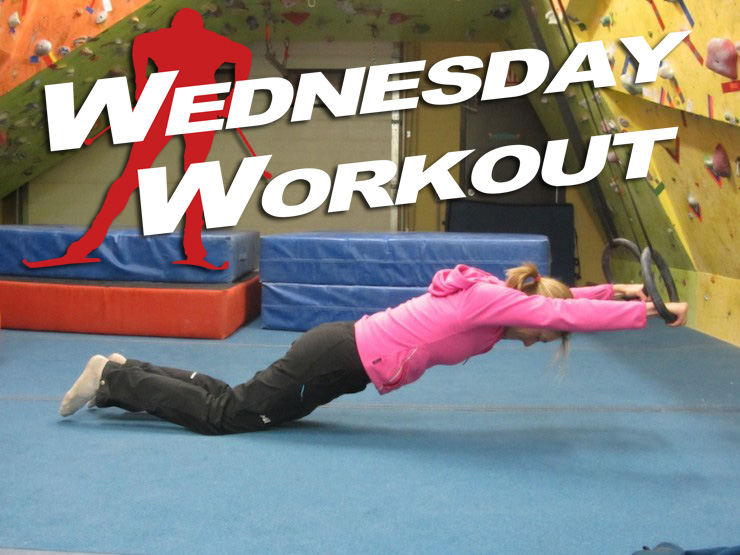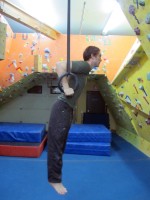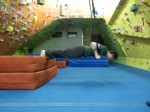
Cross-country skiers are a pretty fit lot. We tend to pride ourselves on overall fitness, and indeed it’s true that ski training does a great job of developing Crossfit-like versatility. Even in strength workouts, the nemesis of many upper-body-challenged athletes, skiers tend to do pretty well. Look at photos of Kikkan Randall, Andy Newell, and other top-level skiers doing weighted pullups and you’ll realize this.

Clearly, skiers need some new exercises to bump up the difficulty level in the weight room. If you find yourself maxing out the difficulty level of your current weight-room exercises, or if you are simply bored with all of them, give strength training with rings a try.
Gymnastic ring training isn’t anything new. Although it and it’s trendier cousin, TRX suspension training, are making some waves in the fitness world right now, rings have been around for ages. However, if you’d like to make significant gains in upper-body and core strength and stability, take a new look at ring training.
Training on rings has a plethora of benefits: it’s fun, the rings are extremely portable and versatile, and the exercises develop strength, coordination, and stability. However, the main benefit is that ring training is HARD. Like REALLY HARD. Ring training is the most difficult training I’ve ever done in a gym.
I started doing ring workouts as training for skiing and all-around fitness at a point when my strength fitness was relatively high, and was amazed at the difficulty in performing relatively benign exercises like dips. Although my ego was somewhat shattered, I quickly discovered that the intense difficulty of ring training paid off mightily in my fitness. If you’d like to experiment with ring training, start off with intro exercises and work up.
A big plus to ring training is that, for all intents and purposes, you can never get too strong for them. As a frame of reference, Olympic gymnastic exercises are rated on a scale from A to E, with A being the easiest. A muscle-up on rings, a fairly difficult exercise for the layman or laywoman, is an A-. Check your local gym to see if they have rings to use or buy your own and bring ’em along!
Exercises
Here are some exercises to get you started, but be creative and do some googling! Many traditional upper body and core exercises can be done (albeit at a harder grade) on rings.
Ring Pushups: Adjust the rings so they are low to the floor. Place your feet on the floor, your hands in the rings, and do pushups. The lower to the floor the rings are, the harder it will be. If you perfect these, prop your feet up on a weight bench level with the rings.
Ring Pullup and Dips: Pullups and dips on rings. Make sure to not let your arms rest on the straps as you do dips. If you want to make the dips harder, let your body come in front of the rings and turn your hands out (see photo).
Ring Rollouts: Similar to rollouts done with a squat bar. Adjust the rings so they are just above the ground. Put your feet close to the rings and bend over to grasp the rings. Slowly move your hands and the rings away from you until you are stretched out and suspended by the rings. Then pull your body back to the starting position using only your core. An easier version of this is to start in a kneeling position instead of standing.
L-sits: Adjust the rings to just above your waist, and support yourself on the rings (as if you were at the top position of a dip). Then lift your legs up to the level of your waist.
Full and Half Levers: Adjust the rings to just above your head. Hang from the rings, and keeping your body rigid in a plank position, raise your body until it is parallel to the ground. An easier version is to bend one leg so your knee is up by your chest (half lever). Don’t let your butt sag!
The Iron Cross: Perhaps not as ski specific as the other exercises, this is a good one to impress your friends. Save it for off-season tomfoolery. Rated a B on the Olympic gymnastic exercise scale, the way to do this one is to start in the support position (the starting position for dips). Lower your body by moving your arms out to the side until your hands are almost level with your shoulders. Yikes!
Katie Bono
Katie is a Canadian contributor at FasterSkier. Hailing from Minnesota, she raced for Dartmouth College and Sun Valley before turning her energies to climbing (and becoming the fastest known woman to ascend Mt. Rainier in Washington). Now based in Canmore, Alberta, she is an athlete ambassador for Millet and works as a mountain guide in Alaska, Washington and South America.








One comment
skigirl
December 4, 2013 at 8:53 pm
Great article, but for one thing:
I’d like to issue a formal request on behalf of all self-respecting Nordic skiers to remove the comparison of ski fitness to Crossfit fitness.